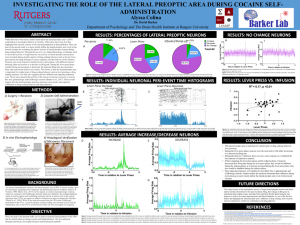Colina, Alyssa: Investigating the Role of the Lateral Preoptic Area During Cocaine Self-Administration

Title: Investigating the Role of the Lateral Preoptic Area During Cocaine Self-Administration
Name: Alyssa Colina
Major: Exercise Science
School affiliation: School of Arts and Sciences
Programs: Aresty Summer Science Program
Other contributors: David Barker
Abstract: While there have been many studies based upon the lateral preoptic area’s (LPO) contribution to locomotion (Shreve & Uretsky, 1990), there have been few that highlighted the specific activity of its neuronal population in drug addiction. Thus, the goal of the present study is to more clearly define the lateral preoptic area’s role in the reward circuitry by examining the phasic activity of lateral preoptic neurons during drug-seeking behavior. Through the use of in vivo electrophysiology, a technique used to record the activity of single neurons, the activity of lateral preoptic area neurons were recorded during specific aspects of drug-seeking behavior such as the pre lever-press period, the drug seeking lever press response, and the delivery of the infusion. Neurons were most responsive during the lever press phase, with different neurons showing either an increase or a decrease in firing rate. During the lever press phase, whether firing rate increased or decreased, the neuronal firing rate also decreased when rats received an infusion of cocaine. This shows us that the lateral preoptic area is important for certain types of drug-seeking behavior such as lever pressing, a drug seeking response. The data also suggests that two different and opposing responses exist. These may represent the activity of the classes of neurons we know to exist in this area: glutamatergic and GABAergic neurons (Barker et al., 2017). These results suggest that the lateral preoptic area may represent a previously unrecognized contributor to drug-seeking behavior and drug addiction.